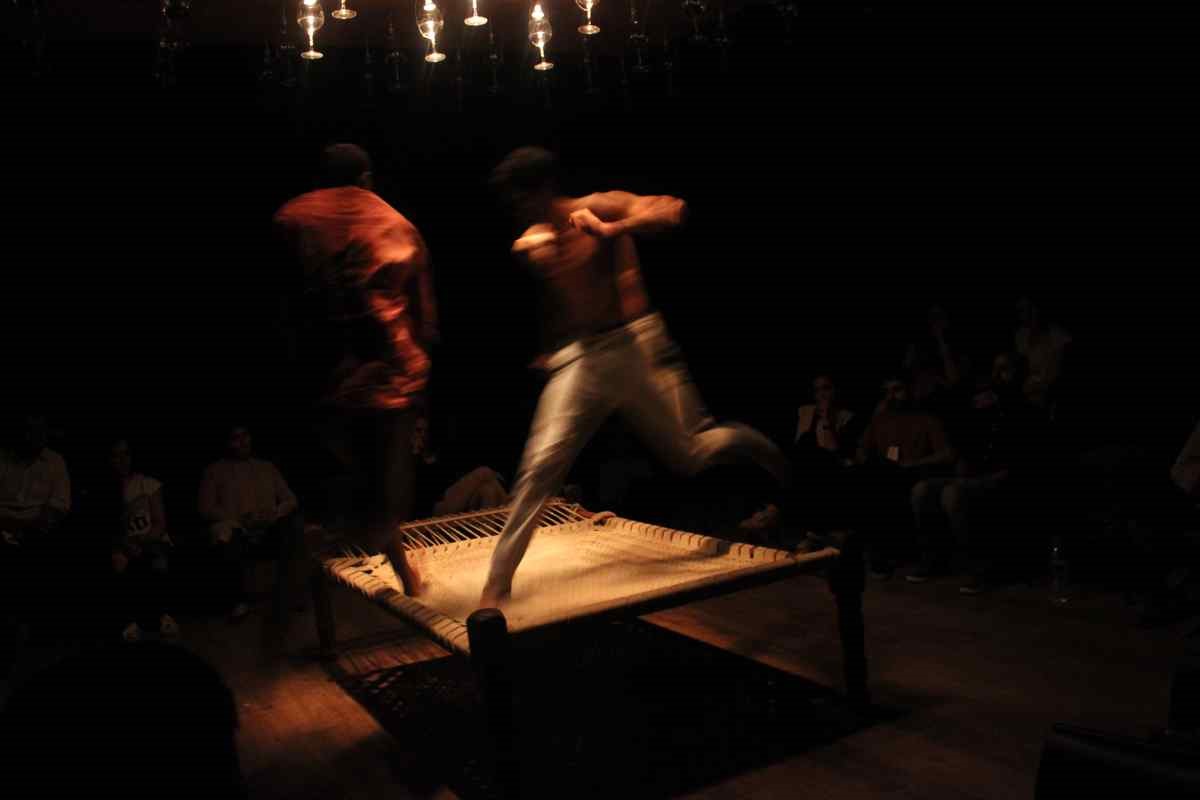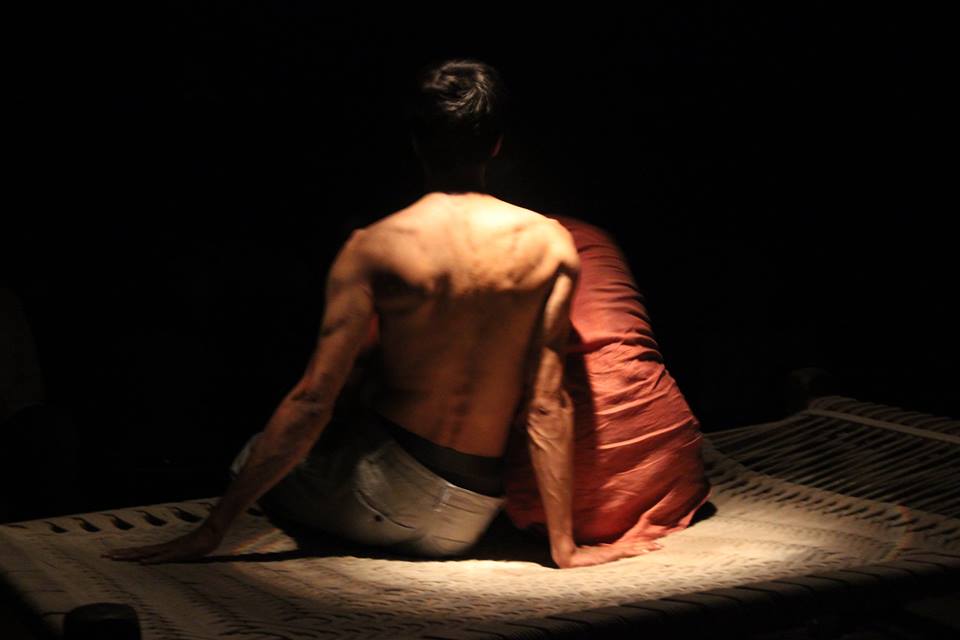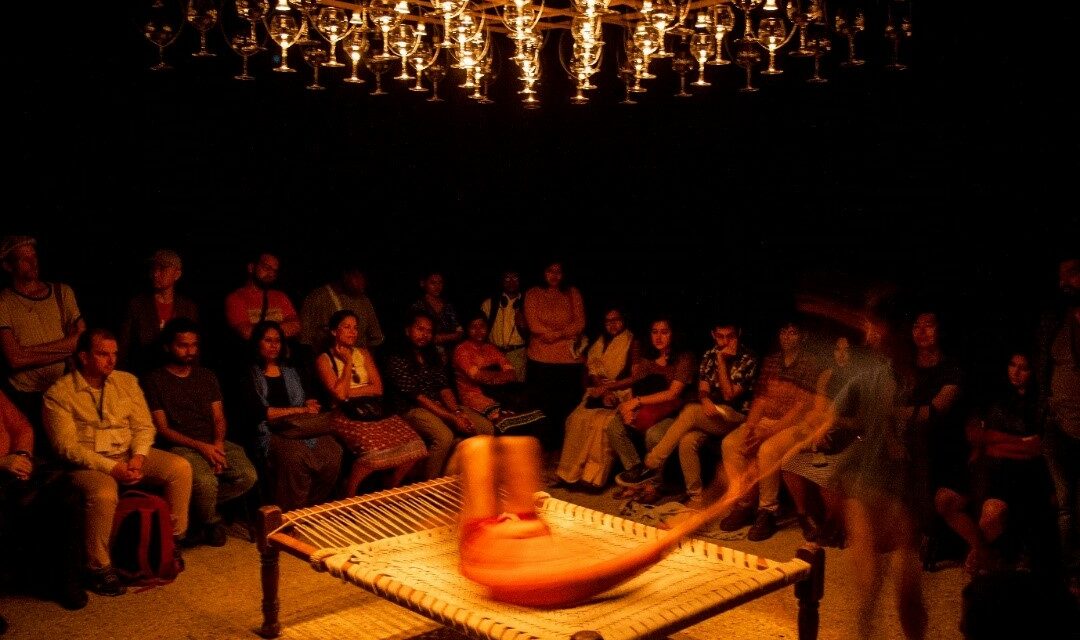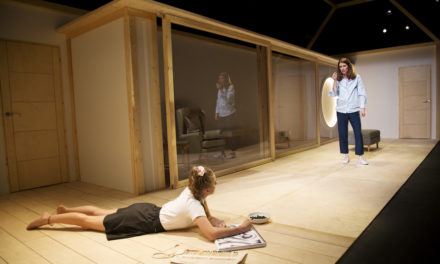Single Performance: Queen-Size, by Sandbox Collective, a dance-performance at Spaces, Chennai, December 2016.
In the wake of the Supreme Court’s understanding of homosexuality under Section 377 as “not an aberration, but a variation,” the recognition of Right to Privacy as a fundamental right that guarantees that “sexual orientation is an essential component of identity” and that LGBTQIA+ identities are “real rights founded on sound constitutional doctrine,” this review explores a performance that took place in December 2016 in Chennai that looks at the dynamics of private and public acts of identity and intimacy.
Spaces, Besant Nagar near the beach in Chennai, India was the perfect setting for an evening of queen-sized intimacy- those that had never seen the performance before milled before the entrance, waiting for the door to open, chatting next to the demolished roof of the kalari. Spaces was set up by Chandralekha, the avant-garde dancer-choreographer who changed the landscape of modern dance in India. It was thus an apt venue, across the beach and its sands.
There are multiple suggestions in the layering of the performance: beginning with the title Queen-Size– a gendered hop away from “king-size” beds generally meant for heteronormative coupling. This held not just an embrace of alternate sexualities but also an open-ended play on the performative aspects of queerness. It also suggested the breadth and depth of intimacy acquired on hostile terrains.

Dancers of Queen-Size by Sandbox Collective. Photo: Courtesy Sandbox Collective.
We were told that we would be allowed in in turns; in the meantime, we could take a peek from one of the windows looking into the room. Spread over two hours, each loop would last for some time while allowing audience members to walk in or out as they please. While waiting for our turn, we were handed copies of late gay activist Nishit Saran’s piece Why My Bedroom Habits Are Your Business first published in the newspaper Indian Express in 2000. Mandeep Raikhy, the choreographer of Queen-Size was Saran’s partner and was inspired by this piece to create the performance. Raikhy, along with Lalit Khatana and Parinay Mehra, both dancers and part of Sandbox Collective, researched and conceptualized the limits of physical intimacy between two men through this performance.
The mise-en-scene was lush with detail; the padded secrecy with which audience members were ushered into the space, the silence in the waiting room outside and the anticipation of entering a dark space lit only by a central focus and the mirroring light of the performers’ bodies. The dancers stood at the center and watched people come and go, and decide to stay.
When we were ushered in, during a lull, we quickly sidled in, catching sly glances at our fellow spectators in the room, eager to sense what might already have happened. We were earlier told that the performance would happen in three loops. We took our positions in one of the corners, watching the audience’s facial expressions and the performers’ bodies, waiting for the next loop of performance to start.
One performer was seated at the edge of the bed, staring at his feet, hands clasped at his knees. His breathing made the muscles of his bare back collapse and expand, as if in silent dialogue with the audience, also watching, breathing mutedly in response. The other performer waited at the door, for the last body to walk through.
While the performer waited at the door, he put on his clothes. One by one, the clothing came on- the shirt, the pants, then the socks. He wiped his sweaty face with a towel, handed it to one of the audience members, then sat down, watching, waiting.
Anticipation in the room ran high. There were some seated in the first row of chairs and many were grouped at the back, leaning at various angles with bodies adjacent to them. The heavy darkness in the room was a participant. The only source of light was a low-hanging assemblage of upturned wine glasses and studded light bulbs pouring shine onto the central prop of the performance: a charpoy (bed) and the empty space around it.
The charpoy– on- the- roof enjoys some traction in innuendo-filled banter and songs in the subcontinent. It stands as a physical marker of illicit pleasure, of hidden nights under stars. It also helps that the charpoy has an ability to stretch and bear its sleeper on riotous pulls and pushes, creaking much like a desi trampoline. In this case, the charpoy was paradoxically exposed and illicit “criminalized” sexual encounters were made legitimate and transparent. The audience was complicit in the act of watching intimacy between two men unfold. Under wine-glass filled light, dark corners and the beady stares of an expectant audience, the performers began.
The piece began slowly, with the gentle touch of fingertips, the touch of the bare back, neck, thighs, and face. The movements were slow and melodic, a flush of touch that lasted and was replaced. Both dancers come from social backgrounds that are not unconventional. The performance shed unspoken desire, bit by bit, rhythmically and sensuously, through two dancers who brought not just grace but also emotion. They walked through the gaps in the seating, brushed past audience members, touched their shoulders, threw clothes on them. The audience was a live, breathing, part of the performance.

Dancers of Queen-Size by Sandbox Collective. Photo: Courtesy Sandbox Collective.
The pace increased. One began following the other, in strides and quick runs. In sudden lunges, one performer would grab another’s clothing and help them out of it. This continued breathlessly until they collapsed in a heap of intimate touches on the floor or on the bed. The sheer physicality of their presence and touch seared itself on to the atmosphere and the audience’s memory; each definition of muscle became prominent as a marker in its own right; bodies defiant in love. The movement was carefully calibrated to not become excessive in its repetition. Patterns were broken before they were formed, with exquisite precision. It was not meant to titillate as pornography might do; it was an invitation to intimacy that included gentle touches as well as frenetic movements and soft sensuality. There were animal-like movements that became difficult to watch and the audience broke the spell to look around surreptitiously at each other. Some were transfixed.
The movements of the actor-dancers were beautifully choreographed, and yet, their passion for each other’s bodies could not be. The idea that these movements could be rehearsed previously seemed like an impossibility. It was desire extended through movement, an endless chase. The bodies caressed each other through the room and each spurt of movement climaxed in an intimate embrace. The embrace itself was prolonged, an act of infinite longing and desire realized through the proximity of bodies. The audience watched every muscle, vein, and tone of the performers’ bodies, caught in the tension between staring and looking away. It was evident, palpable and pleasurable only because forbidden. The music swelled, rose and was subdued in accordance with the bodies.
There was a particularly poignant sequence, which built in intensity and desire, culminating in the two bodies lying next to each other on the charpoy, bronzed, arms twirling, legs meeting legs. One performer was in boxer briefs while the other was in pants, their toned bodies forming the limits of their embrace. Each movement was watched closely by an audience, amazed at privacy enacted so publicly. The darkness of the room cloistered the dancers and the audience in an unspoken bond; photography was prohibited. There was no choice but to fully inhabit many precious moments of intimacy, feeling, as intended, like voyeurs.
Once the loop was completed, the audience members looked like they were stepping out of a trance. The performers sat on opposite sides of the bed, breathing heavily ready to reach for more intimacy. Some looked unwilling to leave. The light seemed to add a flush to every face, but perhaps it was not just the light. The crowds waited to go in, milling around the kalari space. They joined in the silence insisted upon by Raikhy’s team outside the performance space. Many others continued to peek in through the window. Most stayed inside the bedroom to watch intimacy being improvised but also becoming an act of routine, not peripheral to imaginations anymore.
This post was written by the author in their personal capacity.The opinions expressed in this article are the author’s own and do not reflect the view of The Theatre Times, their staff or collaborators.
This post was written by Aprameya Manthena.
The views expressed here belong to the author and do not necessarily reflect our views and opinions.


















